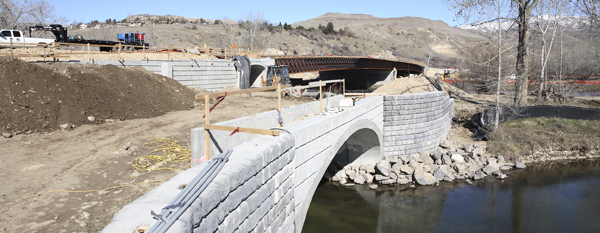
Excellence in Transportation Award:
Construction
Winner: East Parkcenter River Crossing

Participants:
CH2M HILL
Ada County Highway District (ACHD)
HDR Engineering Inc.
McAlvain Construction, Inc.
Justin Bledsoe (ACHD)
Steve Sprague (ACHD)
Bill Thompson (ACHD)
Tobi See (CH2M HILL)
Brian Murphy (McAlvain Construction)
Chad Kitchen (Contech)
East ParkCenter River Crossing:
Providing a critical link in Boise’s transportation system
The East ParkCenter River Crossing (the Project) administered by Ada County Highway District (ACHD) is an ideal candidate for the Excellence in Transportation Award, Construction Category. The construction of this long-awaited transportation link provides motorists, riders, bicyclists, and pedestrians enhanced multimodal connectivity in this thriving commercial and residential community. Traffic congestion and access to the east side of Boise were key drivers for the Project. This new alternative route crossing the Boise River decreases travel times, improves safety, and significantly reduces current congestion by redirecting heavy commuter traffic away from the historical Warm Springs area.
The project comprises:
-
A a new urban roadway;
-
Five bridge structures;
-
Pedestrian and bicycle paths;
-
Interconnection with utilities;
-
Wetland restoration and mitigation;
-
Walling Ditch modifications; and
-
Integration with a local park, as well as residential and business developments.
The major construction items included a 420-foot-long, steel girder bridge; a 110-foot precast concrete bridge; and a 36-foot precast arch that supports a four-lane roadway. Two 14-foot-wide pedestrian tunnels were also constructed to provide safe access under the roadway for pedestrians on the popular Boise Greenbelt. The project was constructed with bicycle and walking paths to connect to existing pathways and pathways planned for the future Marianne Williams Park to the northeast of the project.
Protecting Boise’s valuable resources
Protection of the Boise River and wetland areas was a primary challenge of the Project, along with related groundwater and fisheries issues. Staying out of the Boise River became critical because of the variable flows during the construction period. The U.S. Army Corps of Engineers (USACE) required that the contractor could only work in the river during specified low flows. The CH2M HILL Project Team (Team) solved this problem by using a larger crane to assemble the girders of the Boise River bridge without impacting the river. This ingenious solution saved the client almost 9 months in time savings.
Another project complexity was that all groundwater pumped out of the soil
during construction had to be treated prior to entering any bodies of water or
infiltrating back into the ground. During dewatering, water was pumped into
settling ponds to allow sediment to settle out of the water prior to being
slowly released across a vegetated upland area, where the water either
percolated into the ground or evaporated.
Solutions that optimize constructability
Complexity can also be found in the placement of five structures within the 1,600-foot length of the Project; true ingenuity was required to fit abutments together within a restricted road access area. The Team evaluated the constructibility options to decide which structures should be connected first, and used techanically stabilized earth retaining walls and temporary shoring to create a phasing plan that worked.
The arrival of the 150-foot-long girders was also problematic, given the residential nature and high traffic flow in the area. The project team specified the girders to be transferred to the project site in the middle of the night to avoid affecting traffic during the day.
In addition, ACHD took the steps necessary to be proactive during the Project, acting as “environmental watchdog” and checking on various compliance matters, including U.S. Environmental Protection Agency requirements, wetland onitoring and mitigation, stormwater discharges, and water quality sampling. The results led to the Project being constructed without any environmental permitting
compliance issues or claims.
Published 5-6-2011